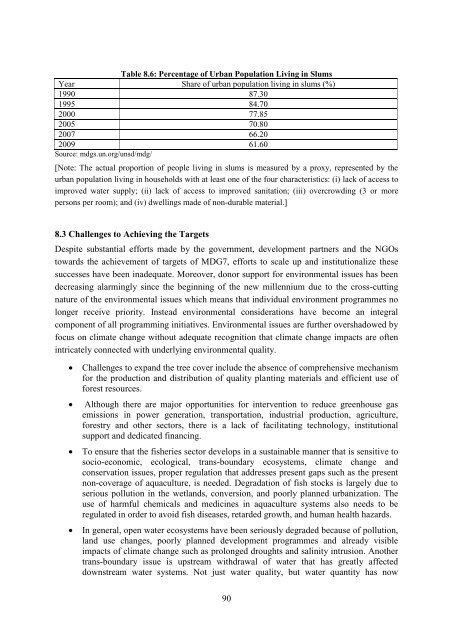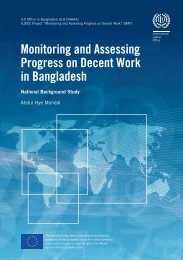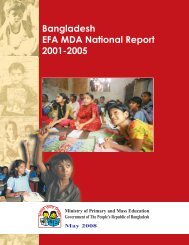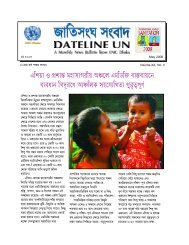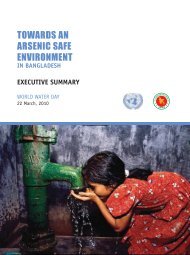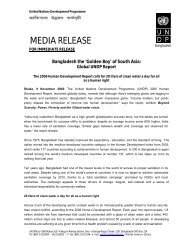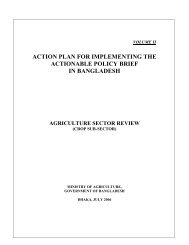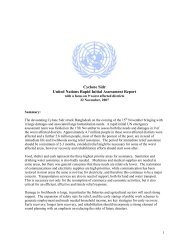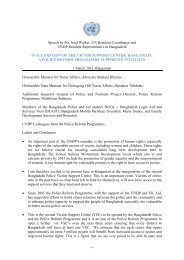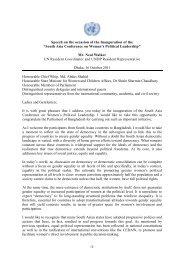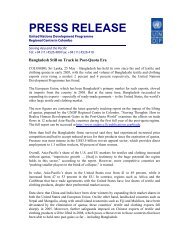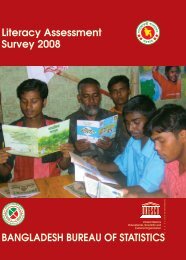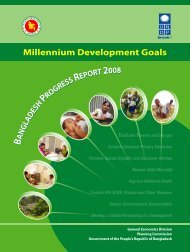MDG Report 2012 - United Nations in Bangladesh
MDG Report 2012 - United Nations in Bangladesh
MDG Report 2012 - United Nations in Bangladesh
- No tags were found...
You also want an ePaper? Increase the reach of your titles
YUMPU automatically turns print PDFs into web optimized ePapers that Google loves.
Table 8.6: Percentage of Urban Population Liv<strong>in</strong>g <strong>in</strong> SlumsYear Share of urban population liv<strong>in</strong>g <strong>in</strong> slums (%)1990 87.301995 84.702000 77.852005 70.802007 66.202009 61.60Source: mdgs.un.org/unsd/mdg/[Note: The actual proportion of people liv<strong>in</strong>g <strong>in</strong> slums is measured by a proxy, represented by theurban population liv<strong>in</strong>g <strong>in</strong> households with at least one of the four characteristics: (i) lack of access toimproved water supply; (ii) lack of access to improved sanitation; (iii) overcrowd<strong>in</strong>g (3 or morepersons per room); and (iv) dwell<strong>in</strong>gs made of non-durable material.]8.3 Challenges to Achiev<strong>in</strong>g the TargetsDespite substantial efforts made by the government, development partners and the NGOstowards the achievement of targets of <strong>MDG</strong>7, efforts to scale up and <strong>in</strong>stitutionalize thesesuccesses have been <strong>in</strong>adequate. Moreover, donor support for environmental issues has beendecreas<strong>in</strong>g alarm<strong>in</strong>gly s<strong>in</strong>ce the beg<strong>in</strong>n<strong>in</strong>g of the new millennium due to the cross-cutt<strong>in</strong>gnature of the environmental issues which means that <strong>in</strong>dividual environment programmes nolonger receive priority. Instead environmental considerations have become an <strong>in</strong>tegralcomponent of all programm<strong>in</strong>g <strong>in</strong>itiatives. Environmental issues are further overshadowed byfocus on climate change without adequate recognition that climate change impacts are often<strong>in</strong>tricately connected with underly<strong>in</strong>g environmental quality.Challenges to expand the tree cover <strong>in</strong>clude the absence of comprehensive mechanismfor the production and distribution of quality plant<strong>in</strong>g materials and efficient use offorest resources.Although there are major opportunities for <strong>in</strong>tervention to reduce greenhouse gasemissions <strong>in</strong> power generation, transportation, <strong>in</strong>dustrial production, agriculture,forestry and other sectors, there is a lack of facilitat<strong>in</strong>g technology, <strong>in</strong>stitutionalsupport and dedicated f<strong>in</strong>anc<strong>in</strong>g.To ensure that the fisheries sector develops <strong>in</strong> a susta<strong>in</strong>able manner that is sensitive tosocio-economic, ecological, trans-boundary ecosystems, climate change andconservation issues, proper regulation that addresses present gaps such as the presentnon-coverage of aquaculture, is needed. Degradation of fish stocks is largely due toserious pollution <strong>in</strong> the wetlands, conversion, and poorly planned urbanization. Theuse of harmful chemicals and medic<strong>in</strong>es <strong>in</strong> aquaculture systems also needs to beregulated <strong>in</strong> order to avoid fish diseases, retarded growth, and human health hazards.In general, open water ecosystems have been seriously degraded because of pollution,land use changes, poorly planned development programmes and already visibleimpacts of climate change such as prolonged droughts and sal<strong>in</strong>ity <strong>in</strong>trusion. Anothertrans-boundary issue is upstream withdrawal of water that has greatly affecteddownstream water systems. Not just water quality, but water quantity has now90


